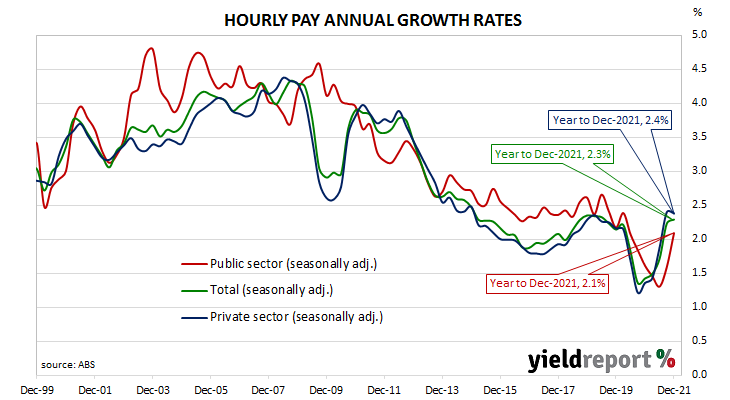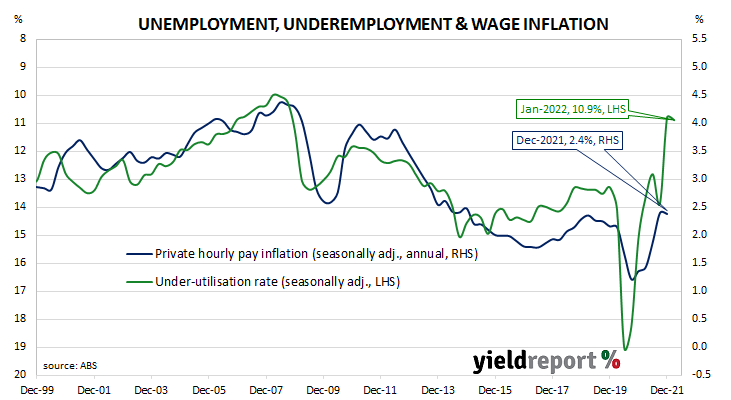Summary: December quarter wages grow by 0.7%, in line with expectations; annual growth rate ticks up from 2.2% to 2.3%; consistent with ongoing gradual acceleration; WPI including bonuses increases annual pace from 2.2% to 3.0%; strongest quarterly result since 2014 but annualised result “well below” 3%; private sector wages up 2.4% over year, public sector up 2.1%; ABS underutilisation rate implies higher wage growth coming.
After unemployment increased and wage growth slowed during the GFC, a resources investment boom prompted a temporary recovery back to nearly 4% per annum. However, from mid-2013 through to the September quarter of 2016, the pace of wage increases slowed, until mid-2017 when it began to slowly creep upwards. After remaining fairly stable at around 2.2% per annum from September 2018 to March 2020, the growth rate slowed significantly in the June and September quarters of 2020 before recovering in 2021.
According to the latest Wage Price Index (WPI) figures published by the Australian Bureau of Statistics (ABS), hourly wages grew by 0.7% in the December quarter. The increase in line with expectations and slightly greater than the 0.6% rise in the September quarter. On an annual basis, the growth rate ticked up from 2.2% to 2.3%.
“The details of the release are consistent with ongoing gradual acceleration in wages growth in response to tighter labour market conditions through mid-to-late last year,” said NAB economist Taylor Nugent.
Domestic Treasury bond yields moved noticeably higher on the day. By the close of business, the 2-year ACGB yield had jumped 8bps to 1.75%, the 10-year yield had gained 7bps to 2.28% while the 20-year yield finished 4bps higher at 2.72%.
In the cash futures market, expectations of the actual cash rate’s path over time remained largely unchanged. At the end of the day, contract prices implied the cash rate would not exceed the RBA’s 0.10% target rate until May and then rise to 0.555% by August. February 2023 contracts implied a cash rate of 1.445%.
“There was a 1.2% rise in the WPI including bonuses taking the annual pace from 2.2% to 3.0%, a pace last seen in September 2019. Employers tend to use variable compensation such as bonuses, to introduce some flexibility into their wage bill. Given how tight the labour market [is], it is it not surprising that bonuses are running ahead of base wages,” said Westpac senior economist Justin Smirk.
“While this was the strongest quarterly result since 2014, it annualised well below the 3% mark at 2.6%…As such, this WPI was not strong enough to make a June rate hike more certain than not,” said ANZ senior economist Catherine Birch.
Wages in both the private and public sectors grew by 0.7% in the December quarter. Over the past 12 months, wages in the private sector increased by 2.4% while public sector wages grew by 2.1%. Annual wage growth in the two sectors had been at 2.4% and 1.6% respectively in the September quarter after revisions.
The “underutilisation rate” is simply the sum of the unemployment and underemployment rates as per ABS monthly statistics. It has a good correlation with private wage growth one quarter in the future and thus it is useful as a leading indicator. However, differences can open up from time to time. January’s underutilisation rate suggests private wage growth is likely to accelerate.
Each quarter the ABS surveys around 3,000 private and public enterprises regarding a sample of jobs in each workplace to measure changes in the price of labour across 18,000 jobs. The results are used to construct the Wage Price Index in a manner similar to the construction of the Consumer Price Index (CPI). Changes in the WPI over time provide a measure of changes in wages and salaries, independently of the type or quantity of work.



